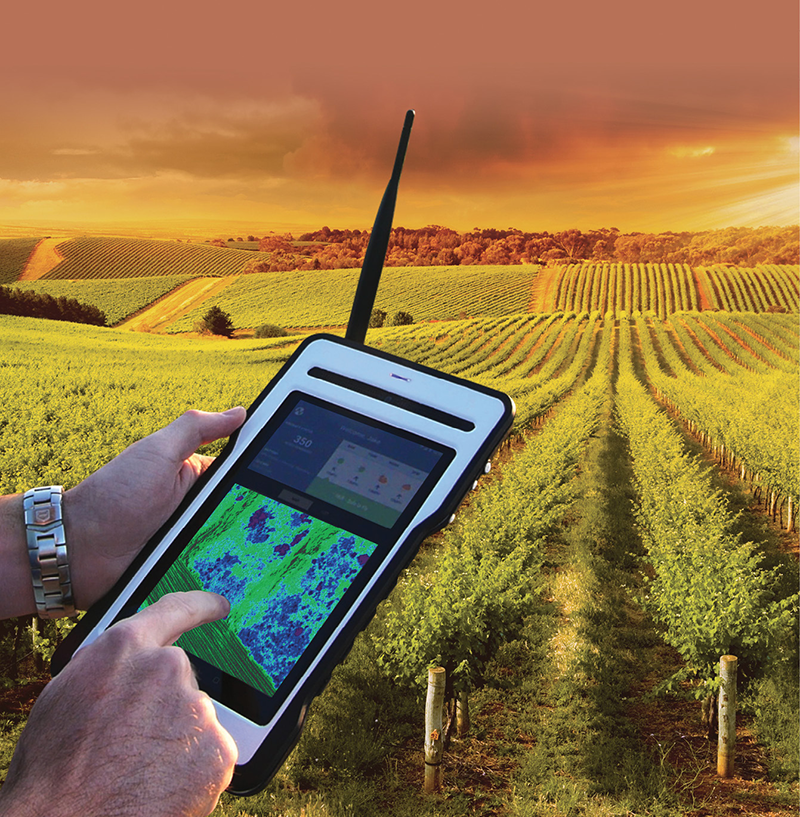Precision Agriculture services using cutting edge methods and technological means (Satellites, UAVs/Drones, Internet of Things, etc)
Precision agriculture is based on agricultural product manufacturing processes through management of field inputs, both spatially and temporally, according to the actual needs of the crop.
Modern precision farming systems rely on the capabilities provided by new technologies in conjunction with information systems such as:
- the recognition of spatial and temporal variation,
- the identification of the real needs of a crop
- the development of technological systems for controlling crop inputs AND
- the collection, processing and transmission of a large number of data and information anywhere, anytime, in real time.
Services of agrometeorology and impacts of climate change/variability, as well as extreme weather events (soil irrigation, disease prediction, production estimation, etc)
Agrometeorology is an interdisciplinary field of knowledge with a more holistic approach than that of climatology or biology. The main scientific fields are atmospheric sciences (weather forecasting and modification) and earth sciences, which are focused on the natural environment (weather phenomena effects), hence it forms a combination of natural and biological sciences as well as an important link between them. Its interdisciplinary character has the advantage of understanding the interactions between the natural and biological worlds.
The hierarchical approach to agrometeorological services is presented below:
- Formation of natural environment and biological reactions
- Biological reactions interpretation
- Agrometeorological forecasts
- Agrometeorological services and strategies
Μελέτη: «Εναέρια χαρτογράφηση αμπελώνα, με σκοπό την εκτίμηση της παραγωγής και την ανίνχευση ζωνών που επηρεάζουν την παραγωγική ικανότητα της καλλιέργειας»
ΠΑΡΕΧΟΜΕΝΕΣ ΥΠΗΡΕΣΙΕΣ
Α. Λήψη εναέριων φωτογραφιών με χρήση ΣΜηεΑ/DRONE
Β. Αποτύπωση και μετρήσεις καλλιέργειας από αέρος
Γ. Εκτίμηση βλαστικής ανάπτυξης
Information technology, telemetry, automation and remote sensing technologies have been developed to such an extent over the recent years that they can now be implemented on a large scale, with low cost and high-quality results (remote sensing systems, satellite and terrestrial weather forecasting systems, mobile telephony, UAV-Drones, wireless sensors and so on). For example, the rational use of irrigation water is always a very important factor in improving the overall water resource management and improving agricultural production.
Today, with the combined use of the aforementioned technologies, crop irrigation is significantly improved, which in turn leads to water saving, improved production and minimization of the environmental footprint as well as the total production costs.
The main benefits of using technological innovations are the following:
- Direct monitoring of critical crop parameters
- Minimization of inputs
- Saving on irrigation water and other natural resources
- Improved production quantity and quality
- Reduction of production costs
- Minimization of the impact on the environment
Research and Development services in the agri-food sector but also in related fields such as construction technology, computers, information technology and the environment.
https://www.fed4fire.eu/demo-stories/cc/pawl/
14.11.2021 FED4Fire - Field Research on Precision Agriculture With LoRa (PAWL) 2nd phase
PANGAEASA as an IoT solutions provider for precision agriculture, is supporting farmers and agronomists all over Greece.
FED4Fire/PAWL demo experimentation research for open field precision agriculture applications, is investigating the performance of LoRa (low-power wide-area network modulation technique) compared to existing ZigBee based solutions.
The exploitation of the knowledge gained from the PAWL experiment, optimize the cost effectiveness and reliability of the provided IoT solutions on various aspects like coverage, throughput and energy efficiency.
PAWL experimentation research based on the existing NITOS/LoRa agricultural testbed of the NITLab/University of Thessaly (http://nitos.inf.uth.gr/) that offers autonomous IoT nodes on the open agro fields, integrated with existing agricultural IoT nodes, in order to have a side-by-side comparison of both solutions in a realistic environment.
Additionally PANGAEASA conducted a series of in house lab experiments in order to measure the power consumption of LoRa and ZigBee modules in their various configuration modes.
The realization of PAWL applied research gained insights to LoRa as an emerging IoT technology and its feasibility in our IoT products, moreover optimizes our services and products by offering reliable IoT nodes focused on precision agriculture applications.







